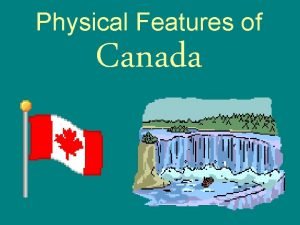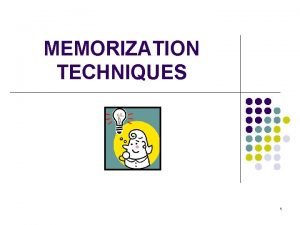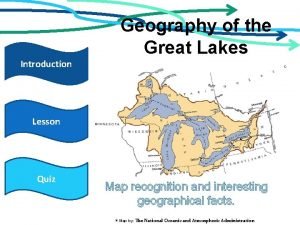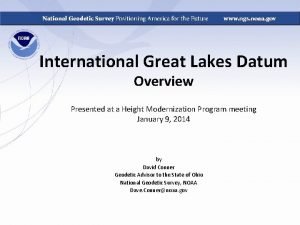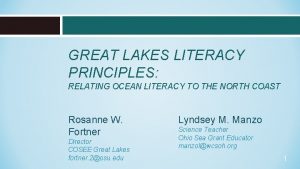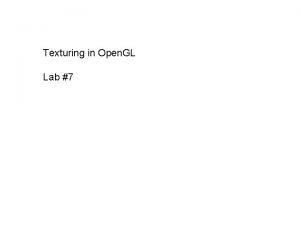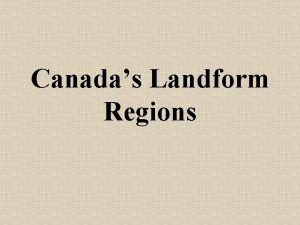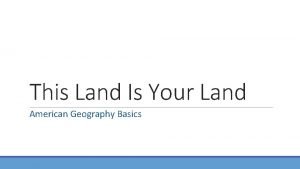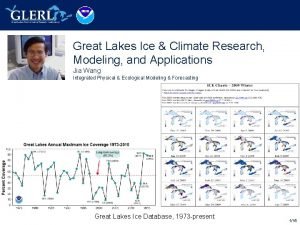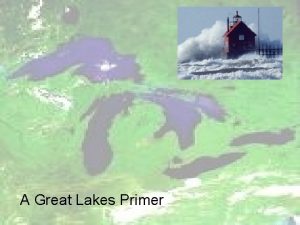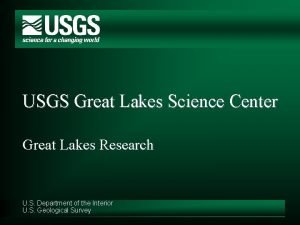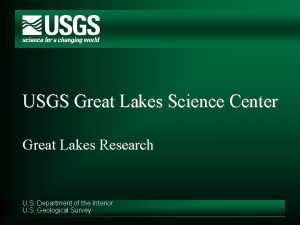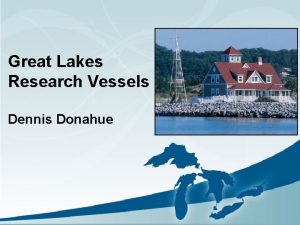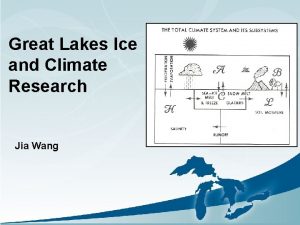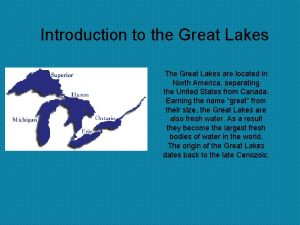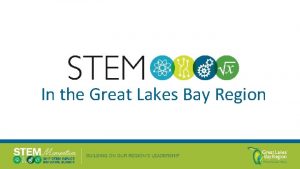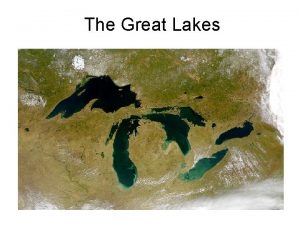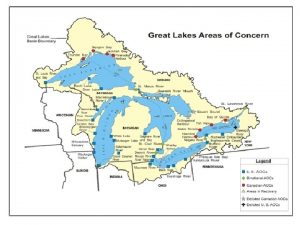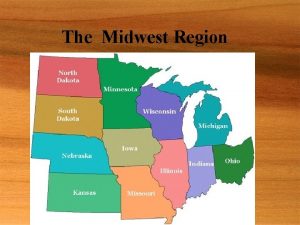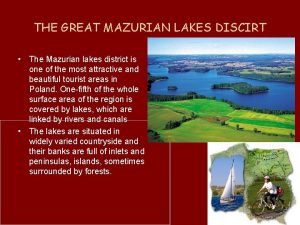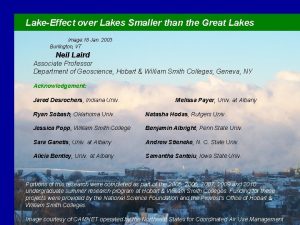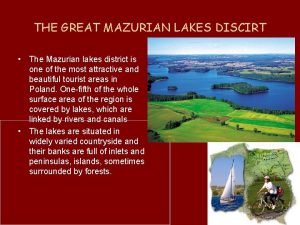Great Lakes Ice Climate Research Modeling and Applications















- Slides: 15

Great Lakes Ice & Climate Research, Modeling, and Applications Jia Wang Integrated Physical & Ecological Modeling & Forecasting Place Photo Here Great Lakes Ice Database, 1973 -present 1/15

IPEMF | Great Lakes Ice & Climate Research 1) R&D: Major global-scale atmospheric teleconnection patterns Warm Phase Cold Phase Wang et al. (submitted) Great Lakes ice correlates to AMO (linear: r=-0. 31) and PDO (non-linear: r=0. 19) 2/15

IPEMF | Great Lakes Ice & Climate Research Great Lake ice correlates to NAO/AO (linear: r=-0. 29), ENSO (nonlinear: r=-0. 22) North Atlantic Oscillation (NAO) (Arctic Oscillation) Pacific North America Pattern (PNA) (El Nino/La Nina, ENSO) Ice and NAO: Linear relationship Ice and ENSO: Nonlinear and asymmetric relationship 3/15

IPEMF | Great Lakes Ice & Climate Research ? ? Hard to predict on medium range Climate Teleconnection Indices C (SAT, ice)=-0. 8 to -0. 9 500 mb-height, SLP, surface air temperature and wind changes Lake Ice Cover Strategy of Projecting Lake Ice 4/15

IPEMF | Great Lakes Ice & Climate Research R 2 A: Medium-range projection of lake ice using climate indices of NAO, Nino 3. 4, AMO, and PDO (GLERL led the efforts with CILER, NIC, academia, Limno. Tech) Hindcast MODIS 03/06/2014 R 2 A: Seasonal prediction model: Blue – old model (Using NAO and ENSO only), r=0. 44 Red – new model (Using NAO, ENSO, and AMO, PDO) r=0. 68 Using the models, GLERL has provided a seasonal ice outlook since 2010: This winter—Annual Maximum Ice Coverage (AMIC) was projected to be 31% in November 2015; On 2/14/2016, AMIC was 34% (average is 53%) 5/15

IPEMF | Great Lakes Ice & Climate Research 2) R&D: Development of Great Lakes Ice-circulation Model (GLIM): Satellite and in situ data used to validate GLIM (Joint efforts by GLERL and CILER) R 2 O: GLIM 5 -day Prediction during 2013 -14 (heavy) ice season Prediction skill has been improved from 2012 to 2014 by nudging daily ice concentration from National Ice Center. Wang et al. (2010). JGLR. 6/15

IPEMF | Great Lakes Ice & Climate Research R 2 O: GLERL Ice Forecast (GLIM) has been incorporated into the GLCFS since 2010 http: //www. glerl. noaa. gov/res/glcfs/ Select “Ice” 5 -day Forecast Ice Concentration Ice Thickness Wang et al. (2010). JGLR; Fujisaki et al. (2012). JGLR; Fujisaki et al. (2013). JGR. 7/15

IPEMF | Great Lakes Ice & Climate Research 3) R&D: Development of 5 -lake unstructured-grid FVCOM with ice Grids Modeled summer circulation Measured Lake Surface Temperature Modeled Lake Surface Temperature Aug Bai et al. (2013). Ocean Modelling; Luo et al. (2012). JGR) 8/15

IPEMF | Great Lakes Ice & Climate Research R&D: Implement the Modified FVCOM-Ice to All Five Great Lakes Observed FVCOM-ice . 1998 Observed (Lake Michigan) Centered differencing Manome and Wang (submitted) Original: EF+RK 4 9/15

IPEMF | Great Lakes Ice & Climate Research 4) R&D: Arctic Dipole Anomaly (DA) is the major forcing that accelerates Arctic summer sea ice decline DA is the 2 nd EOF mode of Sea Level Pressure Anom. north of 70 N (Collaborated with PMEL) Ice-free in 2035? Wang et al. , (2009, 2014). 10/15

IPEMF | Great Lakes Ice & Climate Research R 2 A: Impacts of diminishing summer sea ice on commercial shipping 7000 nm 7600 nm 11000 nm 10000 nm 15000 nm nm = Nautical Mile = 1. 852 km Support of new leadership of Arctic Council by U. S. in 2015 -2017 Lei et al. (2015). Cold Regions Science and Technology. Lei et al. (2016). Polar Research. 11/15

IPEMF | Great Lakes Ice & Climate Research 5) R&D: GLERL’s Coupled Ice-Ocean-Ecosystem Models in the Arctic Ocean CIOM-Ph. Eco. M chl-a Satellite μg/L In situ August 2008 Cloud cover ICEPOM (20 km), thickness Wang et al. (2013, 2014). JGR. Arctic-FVCOM-ice grids (1 -10 km) Arctic-FVCOM-ice, V_sfc (Potential R 2 X in near future) 12/15

IPEMF | Great Lakes Ice & Climate Research Summary • Research revealed the relationships between Great Lakes ice cover and 4 major teleconnection patterns, and led to development of statistical regression models, providing seasonal projection of lake ice using indices of NAO, ENSO, AMO and PDO • Great Lakes Ice-circulation Model (GLIM) (POM-based) was developed for studying interactions between water and ice (heat flux, energy transport), which was transferred to short-term ice forecasting in GLCFS • 5 -lake FVCOM-ice model was implemented and refined to the entire Great Lakes for investigate seasonal and interannual variability, which will be transferred to nowcast/forecast system for NOS, and seasonal projection of lake ice cover at GLERL • Arctic teleconnection patterns, DA and AO, are the major forcing to the Arctic sea ice, while AO is also the major forcing to the Great Lakes ice cover. The Northern Sea Route opening and closing are more closely correlated with DA than AO • Develop Coupled Ice-Ocean Model (CIOM) and coupled (ice-ocean) Physical-Ecosystem Model (Ph. Eco. M) in the Bering-Beaufort-Chukchi Seas and the Arctic Ocean for application and prediction in the near future 13/15

IPEMF | Great Lakes Ice & Climate Research Future Efforts • Continue to update the climate ice database for research and applications by the Great Lakes community, and to provide seasonal forecast of lake ice • Run GL-FVCOM-Ice from 1993 -present and validate the model using observation data • Seasonal forecast/projection of lake ice using GL-FVCOM-Ice • Transition of GL-FVCOM-Ice to NOS/CO-OPS for short-term operational prediction (with Anderson) • Coupled GL-FVCOM-Ice with GL-WRF (with Lofgren) • Implement FVCOM-Ice to the Arctic Ocean (with CILER) 14/15

IPEMF | Great Lakes Ice & Climate Research Questions? 2015/16 winter: Projected: 31% Observed: 34% 15/15
 Model and role modeling theory
Model and role modeling theory Relational modeling vs dimensional modeling
Relational modeling vs dimensional modeling Great lakes scrip center
Great lakes scrip center Great lakes depth comparison
Great lakes depth comparison 5 physical features of canada
5 physical features of canada Acronoyms
Acronoyms Brenntag great lakes chicago
Brenntag great lakes chicago Great lakes quiz
Great lakes quiz International great lakes datum
International great lakes datum Great lakes literacy
Great lakes literacy Csi great lakes region
Csi great lakes region Great lakes labs
Great lakes labs Western cordillera landform region
Western cordillera landform region Great lakes on us map
Great lakes on us map Great lakes acquisition center
Great lakes acquisition center The great lakes
The great lakes




